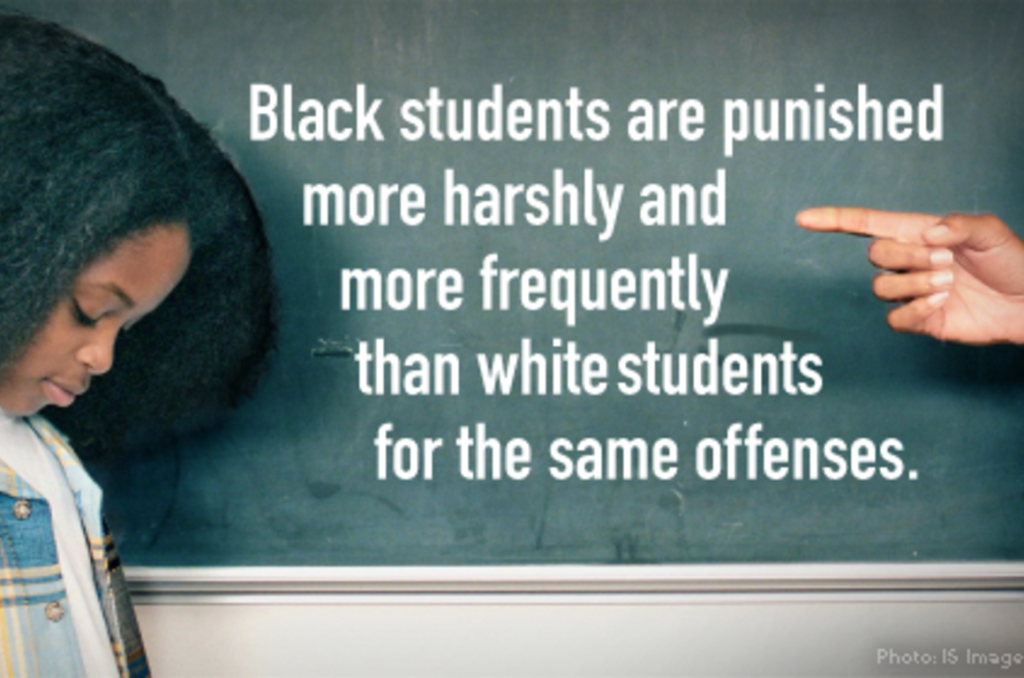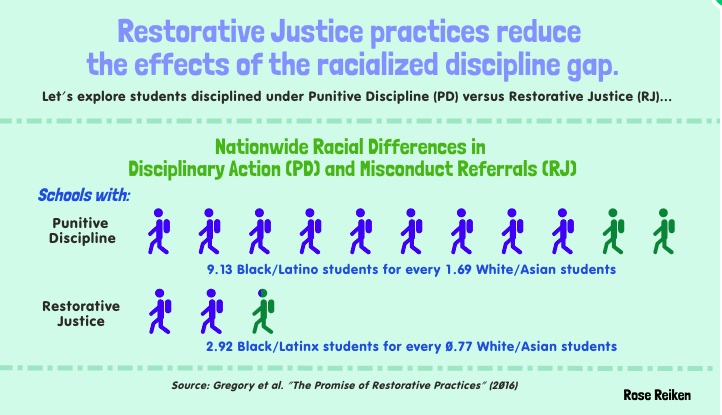by Rose Reiken
Imagine yourself in a classroom. Maybe there are brightly decorated walls and inspirational posters filling the space; maybe there are cement walls and no windows. Either way, two students get into an altercation. One pushes the other and the teacher separates them. What happens next?
In many schools, teachers and administrators punish the student who pushed their classmate with a form of punitive discipline: detention, suspension, or otherwise being removed from the learning environment. From this, the student learns that if they make a mistake, they must isolate themselves from their community, their resources, and their role models. Do not reform behavior, do not apologize to those harmed: leave.
Our current system of school discipline deems students’ missteps so detrimental that they no longer deserve to learn. It instructs students that accountability looks like punishment and pain: not any form of apology or repair. It teaches children, and even more so children of color, which will be explained later in this article, to bear the world alone with their guilt. This cannot possibly reflect the citizenry we want to raise as the next generation.
Punitive Discipline: an Ineffective Method
Punitive discipline has been proven ineffective for the above reasons and many others by countless organizations. The Advancement Project, for instance, concludes that punitive discipline causes a dangerous cycle in which students experience reduced learning time, become disengaged from school, and lose trust in their teachers and connection to their school community, which increases their tendencies towards violent behavior and lowers their academic performance. Unsurprisingly, the United States’ Government Accountability Office (GAO) finds that one suspension doubles a student’s risk of dropping out. This is especially jarring for New York City considering that New York City school suspended at least 49,293 students (4.3% of the student population) in the 2017-2018 school year alone. These students are denied their right to an education and their odds of earning a high school diploma dramatically decrease.

This problem negatively affects all students, but disproportionately affects students of color and creates a racialized discipline gap. The NYC DOE reports that in 2018 Black students comprised 26% of the student population, but represented 45% of reported suspensions. This reality is made worse by the presence of police, and resultantly police violence, in schools with large populations of students of color. For instance, the Center for Popular Democracy finds that 92% of school arrests are Black or Latinx students, despite making up only 67% of total NYC students. These statistics reveal the devastating truth that punitive discipline is not only ineffective, but works to sustain existing cycles of inequality within our schools and our society. Even the NYC Chancellor of Schools himself, Richard Carranza, is quoted stating, “If we’re satisfied with what our [discipline] system produces then we are not looking at the data.” The data proves it: not only does punitive discipline demonstrably fail to reform student behavior or improve educational outcomes, but school staff consistently employ it in ways that systemically disadvantage students of color.
A Method for Reform: Restorative Justice

Source: “Restorative Justice.” Natomas School District. natomasunified.org.
If not through punitive discipline, how else can students exist safely and productively in their schools? In asking this question, many advocates for educational equity look towards restorative justice: a framework that centers relationships between students rather than criminalizing actions. Restorative justice resolves conflicts through finding and addressing root causes to mend the harm caused by negative behavior. This occurs through strategies like community conferencing, peer juries, post-conflict resolution, and reintegration programs.

Source: “Restorative Practices: A Guide for Educators.” The Schott Foundation for Public Education. schottfoundation.org.
With a restorative justice approach, a student who pushes a classmate may meet with their teacher and the implicated peer to discuss the incident and agree on terms in which both students can move on from the situation while still maintaining a productive learning environment. The pusher may apologize to the other student, do community service, or other actions geared towards rebuilding their relationship to both the student and their school community. Restorative justice fosters students viewing themselves as responsible community members, rather than criminals, and teaches students to take advantage of available support systems so they can ask for help when in difficult situations. More information about restorative justice, its proven efficacy, and implementations can be found here for those seeking to learn more.
Restorative justice practices are proven successful in reducing suspensions and increasing student participation in schools, which should be the aim of school discipline. Psychologists have recently found a positive shift in student attitudes towards their own behavior and school after switching to restorative justice; students feel ownership of the process, improve their relationships with peers and school staff, and enter into less destructive conflict overall. Findings like these have not been supported by any conclusive research on punitive discipline.
Further still, restorative justice practices aid in lessening the impact of the aforementioned racialized discipline gap. Schools with restorative justice practices nationwide administered students misconduct referrals to 2.92 Black/Latino students for every 0.77 White/Asian students, which can be compared to schools with punitive methods who disciplined 9.13 Black/Latino students for every 1.69 White/Asian students, as found in a study by Gregory et al. This means that, overall, fewer students are being disciplined with restorative justice practices and those who are experience the impact of racial bias less.

Created with easel.ly
Implementation in New York City
Restorative Justice practices are being implemented in NYC schools through the dedicated work of students, activists, Chancellor Carranza, and Mayor de Blasio. The 2016 City Council budget allocated $2.4 million to restorative justice, which brought RJ coordinators to schools and training for school staff in high need schools. As a result, suspensions decreased by 30% from 2014 to 2016; school arrests also decreased and felonies committed in schools decreased by 35%.
Unfortunately, NYC has failed to fully commit to restorative justice. NYC continues to arrest students in schools. In 2016, 70% of arrests were for misdemeanors and non-criminal violations. While Mayor de Blasio did incorporate funding for RJ to schools, he also added nearly 400 NYPD officers to the school system. The school-to-prison pipeline will run rampant without a full commitment to move away from punitive, criminalizing disciplinary practices. Black and Latinx students’ overrepresentation in school arrests reveals the severe and damaging consequences of racially biased disciplinary practice for students of color when police presence is involved.
A Push Towards Restorative Justice: What You Can Do?
Mayor de Blasio and the NYC DOE must fully commit to restorative justice practices and end racially discriminatory and universally harmful punitive disciplinary policies. Restorative justice practices are significantly more effective for all students and work to decrease racial bias in school discipline. As stakeholders in NYC public education, parents, students, concerned citizens take this awareness and support organizations that demand de Blasio and the DOE commit to restorative approaches to discipline. The Dignity in Schools Campaign-New York, The Restorative Justice Initiative, and The Center for Court Innovation are all organizations with which you can get involved to disrupt our existing system of criminalized, racialized discipline and make New York City a beacon for progressive, equitable school policy.
